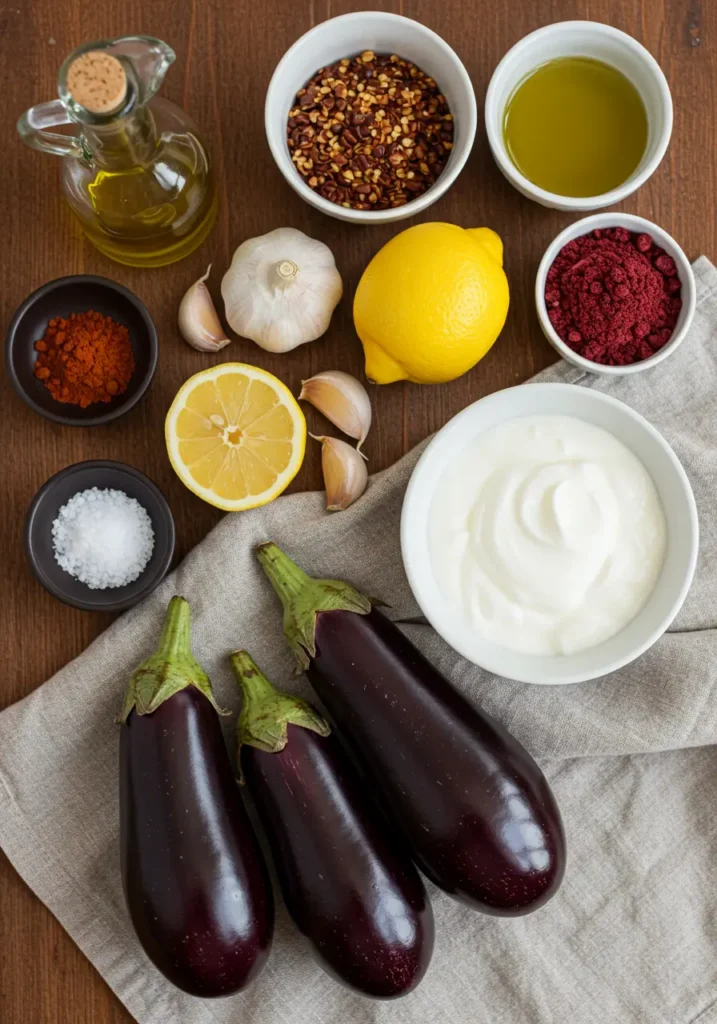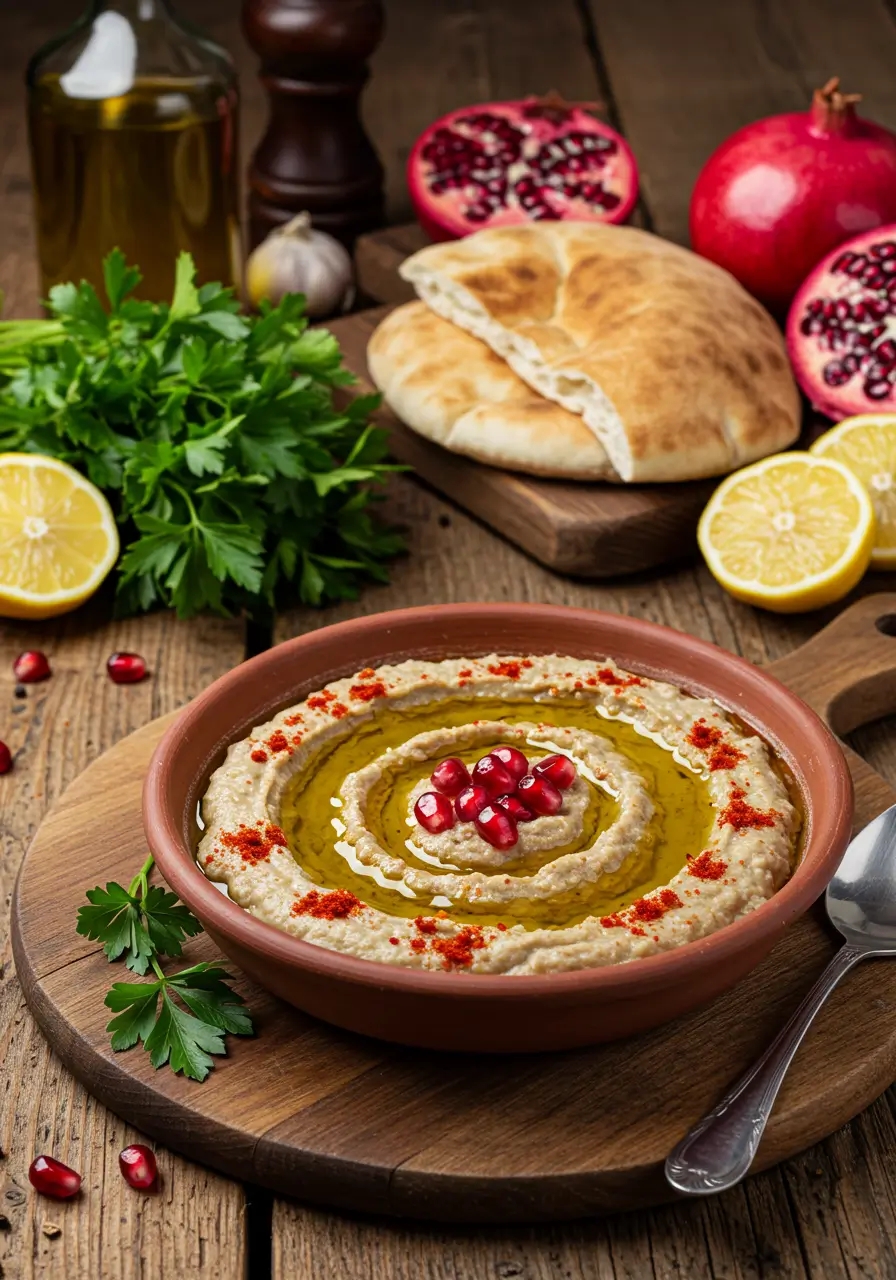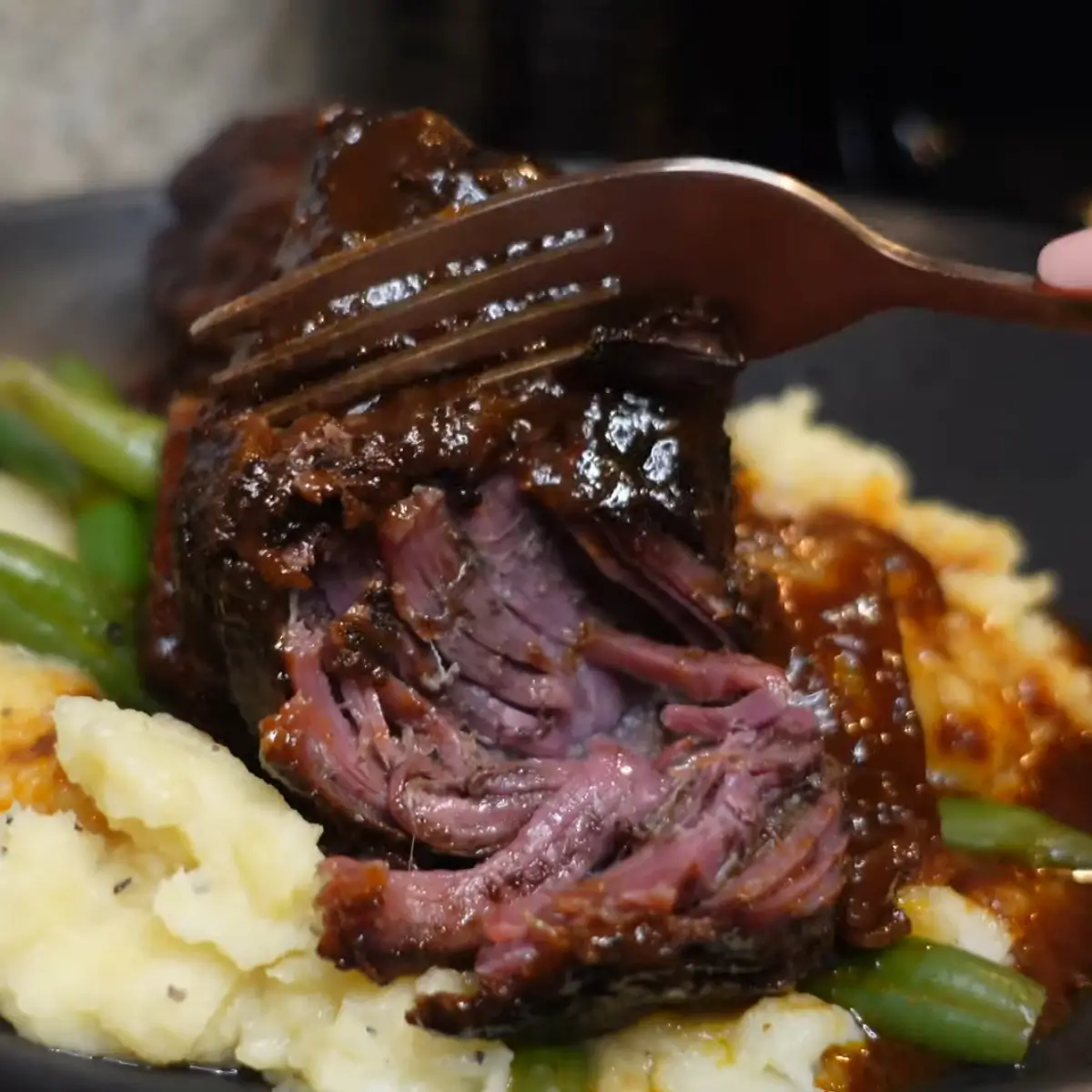Turkish cuisine is full of vibrant flavors, and this Turkish eggplant dip, or patlıcan ezmesi, is one of its most iconic staples. Whether served at lavish gatherings or humble family dinners, this dip holds a timeless spot on the Turkish meze table. It’s more than just a spread — it’s a celebration of smoke, creaminess, and citrus-kissed simplicity.
Turkish Eggplant Dip Recipe
If you’re new to Turkish dips, you’ll find that this recipe pairs beautifully with hearty vegetarian dishes like çiğ köfte or grains such as bulgur wheat pilaf. It’s also a fantastic way to introduce Middle Eastern flavors into your everyday cooking.
Not sure how to roast eggplant without turning it mushy or bitter? This expert oven-roasting guide ensures perfect texture every time.
What Is Turkish Eggplant Dip?
Patlıcan ezmesi is a cold eggplant-based dip traditionally made by roasting eggplant over an open flame, then blending it with yogurt, garlic, olive oil, and lemon juice. The result is a cool, creamy, and slightly smoky dip that’s rich yet refreshing.
Though often compared to baba ghanoush, the Turkish version typically uses strained yogurt instead of tahini, offering a lighter and tangier flavor. It’s typically served cold as part of a meze platter with other small bites and appetizers.
The word “ezme” means “to crush” or “to mash,” and you’ll find that the best versions of this dip are hand-mashed, not blended into a paste — preserving a rustic texture that’s full of character.
Ingredients for Authentic Turkish Eggplant Dip

To keep things traditional yet versatile, you’ll need the following ingredients:
- 2 large eggplants – look for firm, glossy skins
- 1 to 2 garlic cloves, finely minced
- 1/2 cup strained yogurt (Greek or labneh)
(For vegan: substitute with plant-based yogurt or use tahini instead) - Juice of 1 lemon
- 2 tablespoons extra virgin olive oil
- Salt, to taste
- Optional spices: smoked paprika, sumac, Aleppo pepper
- Optional garnish: fresh parsley, pomegranate seeds, or paprika oil
Tips for Choosing Ingredients
- Eggplant: Medium-sized eggplants tend to have fewer seeds and less bitterness.
- Yogurt: Full-fat strained yogurt gives the best texture.
- Lemon juice: Freshly squeezed makes a noticeable difference in brightness.
- Olive oil: Use a peppery, fruity Turkish or Greek-style oil for flavor impact.
How to Make Turkish Eggplant Dip
Step 1: Roast the Eggplant
Roasting is key — it brings out the eggplant’s natural sweetness and infuses it with smokiness.
Option A: Over an Open Flame (Traditional)
- Place the whole eggplant directly on a gas flame or grill.
- Turn with tongs until charred on all sides and fully collapsed (about 15–20 minutes).
- Wrap in foil and rest for 10 minutes to steam and loosen the skin.
Option B: In the Oven (Easier)
- Preheat oven to 400°F (200°C).
- Pierce the eggplants with a fork and place on a baking tray.
- Roast for 35–40 minutes until the skin wrinkles and flesh is tender.

Struggling with roasting methods? This foolproof roasting tutorial shows how to get the texture just right every time.
Step 2: Scoop and Mash
- Once cooled slightly, cut open the eggplants and scoop out the flesh.
- Place in a sieve or cheesecloth for 10 minutes to drain excess moisture (optional but recommended).
- Mash with a fork for a traditional texture, or pulse a few times in a food processor if you prefer smoother dips.
Step 3: Mix and Flavor
- Add garlic, lemon juice, and olive oil to the mashed eggplant.
- Stir in yogurt (or tahini) and salt.
- Taste and adjust — add more lemon for tang, or a pinch of sumac for tartness.
Step 4: Chill and Serve
- Chill in the refrigerator for at least 30 minutes before serving.
- Transfer to a bowl and garnish with parsley, pomegranate seeds, or a drizzle of paprika-infused olive oil.

What Makes Turkish Eggplant Dip Unique?
Unlike its Levantine cousin baba ghanoush, which relies on tahini for richness, Turkish eggplant dip offers a fresher, more acidic profile. The yogurt base balances the smokiness of the roasted eggplant and gives it a cool, velvety finish.
It’s also one of the few dips where texture truly matters. Instead of being overly smooth, it’s often left slightly chunky — with bits of eggplant giving it character.
This dip is a mainstay in Turkish rakı tables and mezze spreads, usually surrounded by grilled flatbreads, tangy salads, and small plates like çiğ köfte or Turkish-style bulgur pilaf.
How to Serve Turkish Eggplant Dip Recipe
Traditional Serving Ideas:
- With warm pita, lavash, or Turkish flatbread
- On a meze platter with olives, hummus, dolmas, and acılı ezme
- Alongside grilled chicken, lamb skewers, or köfte
- Over toast or inside wraps with grilled vegetables
Garnish Suggestions:
- Drizzle with olive oil
- Sprinkle of sumac or paprika
- Fresh herbs: parsley, dill, or mint
- Spoonful of pomegranate seeds for sweet-tart crunch

Turkish Eggplant Dip Storage and Make-Ahead Tips
- Storage: Store in an airtight container in the refrigerator for up to 5 days.
- Flavor tip: It tastes better after 24 hours as the flavors deepen.
- Freezing: Not ideal due to yogurt separation. If using tahini instead of yogurt, you can freeze for up to 2 months.
Turkish Eggplant Dip Recipe Regional Variations
Turkish cuisine varies widely between regions. Here are a few common variations of this dip:
- Patlıcan Salatası: More of a salad-style dip with lemon juice and olive oil, no yogurt.
- With walnuts: A Southeastern Anatolian version using crushed walnuts for crunch.
- With roasted peppers: Adds sweetness and color.
- Spicy version: Includes red pepper paste or crushed chili flakes.
Nutritional Highlights
- Calories (per 1/4 cup): ~90
- Carbs: 4g
- Protein: 2–3g
- Fats: 7g (mostly heart-healthy olive oil)
- Benefits: High in antioxidants, fiber-rich, supports digestion
Great for low-carb, keto, and Mediterranean diets.
Turkish Eggplant Dip Expert Tips for Success
- Always choose eggplants that are heavy for their size and firm to the touch.
- If your eggplant is very bitter, salt and let it rest for 20 minutes before roasting.
- For a smoky boost, add a drop of liquid smoke or smoked paprika.
- Yogurt-based dips should never be frozen — serve fresh or chilled.
FAQs About Turkish Eggplant Dip
Can I make this dip vegan?
Yes, simply use tahini instead of yogurt or substitute with plant-based yogurt.
How do I prevent bitterness in the dip?
Choose smaller eggplants and salt them before roasting. Also, avoid undercooking — eggplant should be fully soft.
Can I use a blender or food processor?
Yes, but for an authentic texture, hand-mashing is best.
What’s the difference from baba ghanoush?
Baba ghanoush uses tahini and parsley, whereas Turkish eggplant dip typically uses yogurt and olive oil, making it lighter.
Can I serve this warm?
It’s traditionally served chilled or room temperature, but warm is fine if freshly made.
Turkish Eggplant Dip Final Thoughts
This Turkish eggplant dip is a dish that bridges rustic tradition and refined simplicity. Whether you’re entertaining guests or meal prepping for the week, it adds instant flavor and authenticity to your table. Serve it with vegetarian Turkish mezze dishes or a hearty grain-based pilaf to complete your Turkish-inspired spread.
Want more dips and spreads like this? Stay tuned as we continue exploring the vibrant world of Turkish cuisine.

Turkish Eggplant Dip – Creamy, Smoky & So Easy
Ingredients
- 2 large eggplants
- 1 to 2 garlic cloves finely minced
- 1/2 cup strained yogurt or Greek yogurt
- 2 tablespoons extra virgin olive oil
- Juice of 1 fresh lemon
- 1/2 teaspoon salt or more to taste
- 1/4 teaspoon smoked paprika or sumac optional
- Fresh parsley pomegranate seeds, or paprika oil for garnish
- Serve with warm flatbread lavash, or pita
Instructions
- Roast the whole eggplants on an open flame or in a 400°F (200°C) oven for 35–40 minutes until completely soft and charred
- Let the roasted eggplants cool slightly, then peel and discard the skins
- Scoop out the flesh, place in a colander or cheesecloth, and let drain for 10 minutes to remove excess moisture
- Mash the eggplant flesh with a fork for a rustic texture or pulse lightly in a food processor for a smoother dip
- Mix in the garlic, lemon juice, olive oil, yogurt, and salt until fully incorporated
- Taste and adjust seasonings, adding smoked paprika or sumac for an extra flavor boost
- Transfer to a serving bowl, garnish with fresh herbs, pomegranate, or paprika oil
- Chill for 30 minutes before serving to allow flavors to blend
- Serve cold or at room temperature with bread or as part of a mezze platter
Notes
- You can replace yogurt with tahini for a vegan version without losing creaminess
- For stronger flavor, chill the dip overnight and serve the next day
- Roast the eggplant over open flame for a more intense smoky flavor
- Add crushed walnuts or chopped roasted red peppers for regional variations
- If the eggplants are bitter, salt and let them sit for 20 minutes before roasting











4 thoughts on “Best Turkish Eggplant Dip Recipe – So Easy & Tasty”